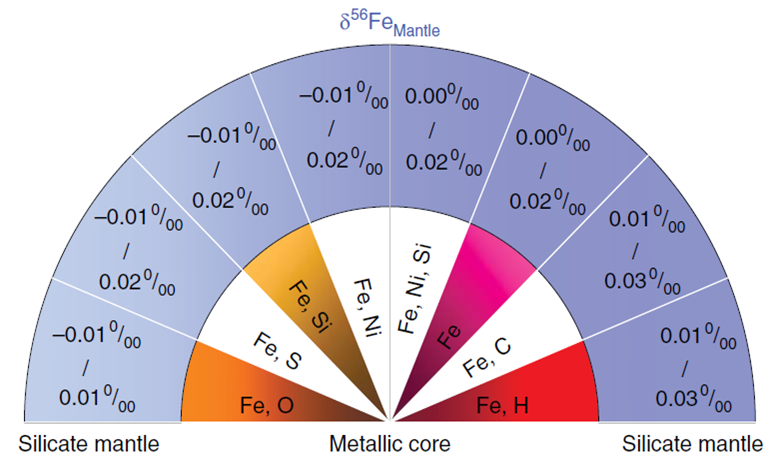Fe isotopic fractionation between mantle and metallic core - Dr. Jung-Fu Lin
FEBRUARY 21, 2017
Equilibrium iron isotope fractionation is vital to understand the isotopic heterogeneity within the Earth, and therefore useful to reveal Earth’s early history and its geodynamical evolution. New work led by HPSTAR scientists, Dr. Jung-Fu Lin and graduate student Hong Yang, and Dr. Nicolas Dauphas from the University of Chicago found that the equilibrium iron isotope fractionation between silicate and iron at conditions relevant to Earth’s core formation is quite small relative to the observed heavy iron isotope enrichment in terrestrial basalts. This suggests that the interplanetary variability in iron isotopic composition cannot be ascribed to core formation. The work is published by Nature Communications (doi:10.1038/ncomms14377).
Iron, as one of the most abundant elements in the Earth, is shown to have differentiated in Earth’s crust, mantle and core with different valence states — a core dominated by metallic Fe, a mantle that is rich in ferrous Fe2+, and the surface characterized by oxidative environments where iron is found mostly as ferric Fe3+. Geoscientists suggest that iron isotopes fractionation, a process that affects the relative abundance of isotopes, might be influenced by the redox state of iron and help understand how this layered structure was formed.
All isotopes of iron behave the same way chemically but slightly differ in their masses. This tiny mass difference may cause some variations in iron isotope distribution in different layers of the earth.
“We need to know how iron isotopes are partitioned at equilibrium between core metal and mantle silicate in order to probe the core-mantle segregation and the core formation conditions,” said Dr. Lin, a professor of the University of Texas and a staff scientist at HPSTAR.
Before now, the equilibrium iron isotopic fractionation between metallic iron and silicate post-perovskite at Earth’s core-mantle boundary (CMB) conditions was considered sufficiently large to cause significant isotopic fractionation between the mantle and the core.
 However, the team experimentally found that the equilibrium iron isotope fractionation between silicate and iron relevant to core formation in Earth is ~0–0.02 ‰, which is small relative to the measured iron isotope enrichment in terrestrial basalts of ~+0.1‰.
However, the team experimentally found that the equilibrium iron isotope fractionation between silicate and iron relevant to core formation in Earth is ~0–0.02 ‰, which is small relative to the measured iron isotope enrichment in terrestrial basalts of ~+0.1‰.
“This means that high-pressure mantle-core equilibration cannot be responsible for the heavy Fe isotopic composition measured in basalts. Therefore, the Fe isotopic composition of the mantle is representative of the bulk Earth”, Dr. Lin explained.
More importantly, they discovered that silicon and sulfur, two major light element candidates in the Earth’s core, and nickel alloyed with iron would also produce minimal isotopic fractionation in the silicate mantle relative to the bulk Earth.
“Our results support the notion that core formation of planetary bodies in the solar system is unlikely to fractionate significantly stable isotope ratios for elements like Si, Cr, and Fe. This study calls for a need to understand the isotope anomaly in basalts,” Dr. Lin added.
Caption: Schematics for d56Fe isotope signatures in the bulk silicate Earth with regard to varying compositional models of Earth's core.
Other media report: Science Daily: https://www.sciencedaily.com/releases/2017/02/170221110719.htm
科学网:http://paper.sciencenet.cn/htmlpaper/201722215183230242996.shtm
了解地球的化学成分对揭示地球起源至关重要。目前对地球铁同位素的观测表明地球表面的 玄武岩比球粒陨石(地球的组成物质)稍稍偏重。这种细微的差别之前被认为可能来自地幔和地核间的铁同位素分馏,但是这种可能性还未被检验过。在本工作中,高科中心的林俊孚研究团队通过了高压下原位的铁原子的力常数测量,揭示了高压下硅酸盐和铁合金之间有限的铁同位素分馏。因此,核幔分异并不能够导致玄武岩中偏重的铁同位素特征。本工作关于各种铁合金的测量工作还揭示了硫,硅,镍的加入并不能显著改变铁的力常数,因此这些轻元素的合金效应对铁同位素分馏影响也是有限的。因此我们可以推断,行星体内部发生的核幔分异过程将不会对元素铁,铬,硅等产生显著的同位素分馏。
